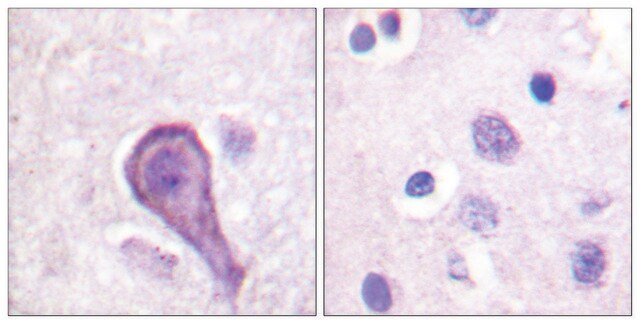Recommended Products
biological source
rabbit
Quality Level
antibody form
affinity purified immunoglobulin
antibody product type
primary antibodies
clone
polyclonal
purified by
affinity chromatography
species reactivity
human
manufacturer/tradename
Chemicon®
technique(s)
immunohistochemistry: suitable (paraffin)
NCBI accession no.
UniProt accession no.
shipped in
dry ice
target post-translational modification
unmodified
Gene Information
human ... RHO(6010)
Specificity
Recognizes Rhodopsin.
Immunogen
Synthetic peptide from the 2nd extracellular domain of human Rhodopsin.
Application
Anti-Rhodopsin Antibody detects level of Rhodopsin & has been published & validated for use in IH(P).
Immunohistochemistry on paraffin embedded tissue sections.
Optimal working dilutions must be determined by the end user.
Optimal working dilutions must be determined by the end user.
Research Category
Neuroscience
Neuroscience
Research Sub Category
Sensory & PNS
Sensory & PNS
Physical form
Affinity purified immunoglobulin. Liquid in PBS, with less than 0.1% sodium azide.
Storage and Stability
Maintain at -70°C in undiluted aliquots for up to 6 months after date of receipt. Avoid repeated freeze/thaw cycles.
Other Notes
Concentration: Please refer to the Certificate of Analysis for the lot-specific concentration.
Legal Information
CHEMICON is a registered trademark of Merck KGaA, Darmstadt, Germany
Disclaimer
Unless otherwise stated in our catalog or other company documentation accompanying the product(s), our products are intended for research use only and are not to be used for any other purpose, which includes but is not limited to, unauthorized commercial uses, in vitro diagnostic uses, ex vivo or in vivo therapeutic uses or any type of consumption or application to humans or animals.
Not finding the right product?
Try our Product Selector Tool.
recommended
Product No.
Description
Pricing
Storage Class Code
10 - Combustible liquids
WGK
WGK 2
Flash Point(F)
Not applicable
Flash Point(C)
Not applicable
Certificates of Analysis (COA)
Search for Certificates of Analysis (COA) by entering the products Lot/Batch Number. Lot and Batch Numbers can be found on a product’s label following the words ‘Lot’ or ‘Batch’.
Already Own This Product?
Find documentation for the products that you have recently purchased in the Document Library.
Riccardo Natoli et al.
Investigative ophthalmology & visual science, 58(7), 2977-2990 (2017-06-13)
Complement system dysregulation is strongly linked to the progression of age-related macular degeneration (AMD). Deposition of complement including C3 within the lesions in atrophic AMD is thought to contribute to lesion growth, although the contribution of local cellular sources remains
Kristin L Gardiner et al.
Molecular therapy : the journal of the American Society of Gene Therapy, 28(1), 266-278 (2019-10-13)
The form of hereditary childhood blindness Leber congenital amaurosis (LCA) caused by biallelic RPE65 mutations is considered treatable with a gene therapy product approved in the US and Europe. The resulting vision improvement is well accepted, but long-term outcomes on
Riccardo Natoli et al.
Molecular vision, 24, 201-217 (2018-03-13)
Systemic increases in reactive oxygen species, and their association with inflammation, have been proposed as an underlying mechanism linking obesity and age-related macular degeneration (AMD). Studies have found increased levels of oxidative stress biomarkers and inflammatory cytokines in obese individuals;
Isabel Pinilla et al.
Experimental eye research, 150, 122-134 (2015-11-03)
To characterize the relationship between fundus autofluorescence (FAF), Optical Coherence Tomography (OCT) and immunohistochemistry (IHC) over the course of chronic retinal degeneration in the P23H rat. Homozygous albino P23H rats, Sprague-Dawley (SD) rats as controls and pigmented Long Evans (LE)
Sizar Kamar et al.
International journal of molecular sciences, 21(2) (2020-01-18)
Biblical references aside, restoring vision to the blind has proven to be a major technical challenge. In recent years, considerable advances have been made towards this end, especially when retinal degeneration underlies the vision loss such as occurs with retinitis
Our team of scientists has experience in all areas of research including Life Science, Material Science, Chemical Synthesis, Chromatography, Analytical and many others.
Contact Technical Service






